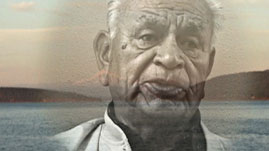Teachers' Domain - Digital Media for the Classroom and Professional Development
User: Preview

Source: A Northwest Indian College production for NASA's Where Words Touch The Earth



In this video segment, learn about subsistence fishing and harvesting. Hear from an Elder who speaks about how he used to go trolling (fishing) for salmon with his father, uncles, and cousins when he was young. He recalls that they noticed that the salmon were moving farther offshore, into deeper water. They suspected it was because the water was warming. The video segment was adapted from a student video produced at Northwest Indian College in Bellingham, Washington.
For Native communities that follow a traditional subsistence lifestyle, changes in climate can have significant implications for their way of life. A subsistence culture is closely tied to the environment: Those practicing subsistence living rely on natural resources for food, clothing, and shelter and have an intimate knowledge of the properties, patterns, and cycles of the natural world. As a result of this close relationship with nature, Native populations are often the first to observe changes in the environment and may discern differences in the environment that have not yet been noticed or studied by Western scientists.
As seen in the featured video, the Lummi people of Washington State observed changes in the salmon population beginning in the 1940s and 1950s. The men who went out trolling for salmon noticed that the fish were no longer abundant in their usual location near shore. The fish had not disappeared but had moved to deeper water farther from shore. The fishermen thought that perhaps warming waters were affecting the salmon.
At that time, there was little interest or discussion of climate change in the Western scientific community. The idea that increased carbon dioxide levels in the atmosphere were causing global warming was only just starting to be explored. But the Lummi people were keenly aware of the consequences of environmental changes and were already making observations of climate variability.
Recent research has shown that there is indeed a connection between salmon abundance and ocean temperature changes. In particular, the Pacific Decadal Oscillation (PDO)—the pattern of Pacific climate variability over periods of approximately 20–30 years—seems to affect salmon populations. The PDO alternates between warm and cool phases; during the warm phase, part of the eastern Pacific warms while the western part cools (and vice versa during the cool phase). Warm phase PDO is correlated with reduced abundance of certain types of salmon in the Pacific Northwest, while cool-phase PDO is associated with above average abundance of those fish.
Salmon are quite sensitive to environmental conditions. For example, they require water with a high oxygen content, which means they thrive best in cool water. They also need clean gravel beds with good water flow in rivers for spawning. Warmer water holds less oxygen than colder water does and is thus unfavorable to salmon. It also makes them more susceptible to infection by parasites. Changes in climate can also affect salmon in other ways, such as by altering the abundance of their food sources or their predators, and higher stream flows and increased sediment in rivers can be damaging to young salmon. Furthermore, because salmon live in different habitats throughout their life cycle, changes in the conditions of any one area (stream, estuary, or ocean) can affect their survival.
 Loading Standards
Loading Standards Teachers' Domain is proud to be a Pathways portal to the National Science Digital Library.
Teachers' Domain is proud to be a Pathways portal to the National Science Digital Library.
